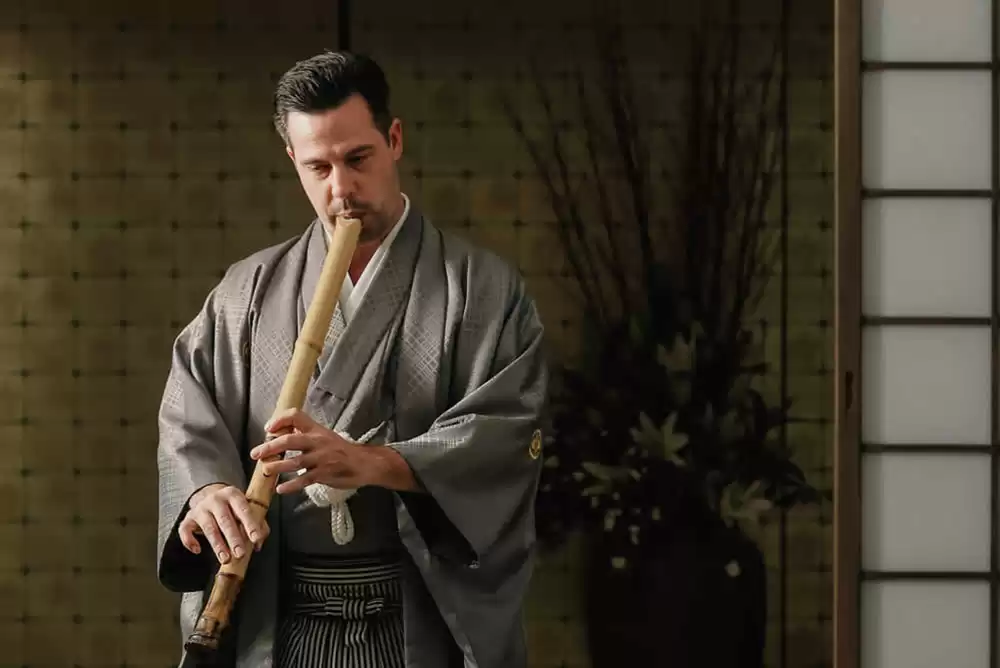
01 Apr Shakuhachi for Beginners: How to Learn the Traditional Japanese Flute
The shakuhachi, a traditional Japanese flute, has captivated the hearts of music enthusiasts and spiritual seekers alike for centuries. This beautiful instrument, made from bamboo, has played a significant role in Japanese culture, often used in Zen meditation and traditional music ensembles. If you are an aspiring shakuhachi enthusiast, this beginner shakuhachi guide is here to help you understand the instrument, choose the right shakuhachi, learn to play, practice techniques, find a teacher or mentor, and immerse yourself in the shakuhachi community.
Understanding the Shakuhachi
Understanding of the Shakuhachi begins with the basic anatomy of the instrument. Essential pieces of that anatomy include:
Bamboo material: The shakuhachi is traditionally crafted from the root end of the Madake bamboo species, known for its strength and resonance.
Root end: The broader end of the flute, where the mouthpiece is located.
Notches and finger holes: Shakuhachi has five finger holes (four on the front and one on the back) for producing different notes.
Different types of shakuhachi include:
Standard (ji-ari) and jinashi shakuhachi: Ji-ari shakuhachi have a lacquer lining, while jinashi are entirely bamboo, producing a warmer and more natural sound.
Various lengths and keys: Shakuhachi flutes come in different lengths, affecting the key and range of the instrument.
The shakuhachi is often used in ensembles alongside koto and shamisen or as a solo instrument for meditation and spiritual practice.
Choosing Your First Shakuhachi
Determine your willingness to spend, as shakuhachi prices can vary widely.
Material and craftsmanship: Choose a well-crafted instrument made of quality bamboo.
Length and key: Consider the size and key that suits your musical goals and physical comfort.
Research and seek recommendations for reputable shakuhachi makers and vendors to ensure you purchase a quality instrument.
Consider renting a student shakuhachi before committing to a purchase, giving you a chance to experience playing the instrument without significant investment.
Learning to Play the Shakuhachi
Develop a comfortable posture and learn the correct hand positions for holding the shakuhachi.
Master the unique embouchure required for the shakuhachi and learn how to produce sound by directing your breath across the notch in the mouthpiece.
Familiarize yourself with finger placements for each note and practice playing scales.
Learn the notation system used in shakuhachi sheet music, which differs from Western notation.
Practicing Shakuhachi Techniques
Learn to adjust your pitch by changing the angle of your breath. These are called Meri and Kari (pitch modulation). Develop control over your breath to produce a vibrato. Master the art of smoothly transitioning or “sliding” between notes. Establish a regular practice routine to build your skills and overcome common challenges.
Focus on proper embouchure, finger placement, and breath control while practicing. Break down difficult passages into smaller sections and gradually increase the tempo as you gain proficiency.
Finding a Shakuhachi Teacher or Mentor
In-person lessons allow immediate feedback and hands-on guidance, helping you develop proper technique and avoid bad habits.
If in-person lessons are unavailable or feasible, consider online shakuhachi lessons or tutorials, such as those offered by Shawnee Schroeder at Chikushin Shakuhachi.
Attend workshops, masterclasses, or retreats to learn from experienced shakuhachi sensei and connect with fellow enthusiasts.
Immersing Yourself in the Shakuhachi Community
Connect with other shakuhachi players through local ensembles, online forums, and social media groups to share experiences, tips, and resources.
Experience the beauty of the shakuhachi by attending live performances, concerts, and recitals to gain inspiration and deepen your appreciation for the instrument.
Build connections with other shakuhachi players, teachers, and makers to stay informed about events, opportunities, and the latest developments in the shakuhachi world.
Conclusion
Learning the shakuhachi is a rewarding, lifelong journey that offers musical fulfillment and spiritual and personal growth.
As you develop your shakuhachi skills, embrace the instrument’s meditative qualities and explore its deep connections to Zen Buddhism and Japanese culture.
Stay dedicated to your practice, remain open to learning, and find joy in the journey as you become a part of the rich tradition of the shakuhachi.
By following this beginner’s guide and immersing yourself in the shakuhachi community, you will be well on your way to mastering this beautiful and enchanting instrument. So, take a deep breath, pick up your shakuhachi, and embark on an inspiring musical adventure by purchasing a Chikushin Shakuhachi flute today.


